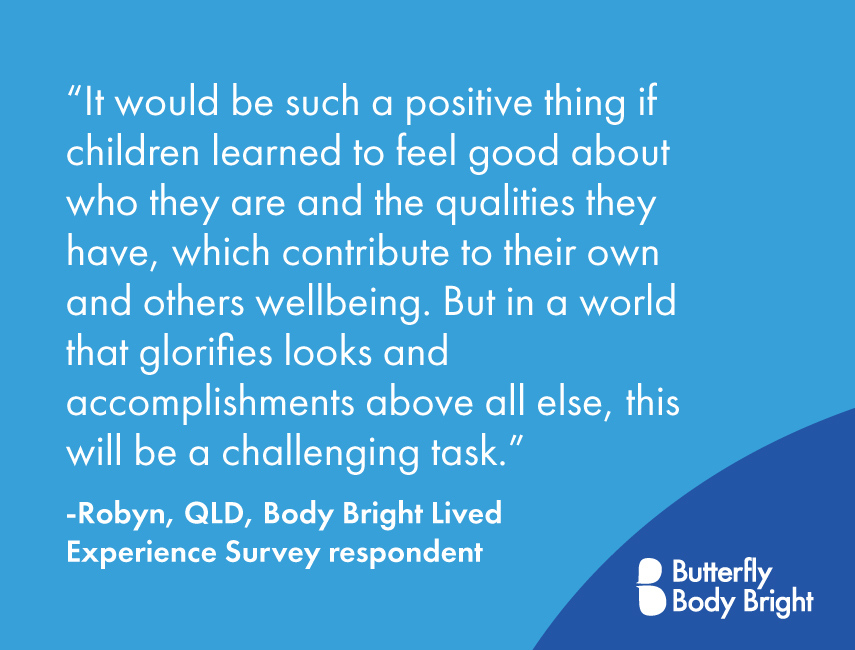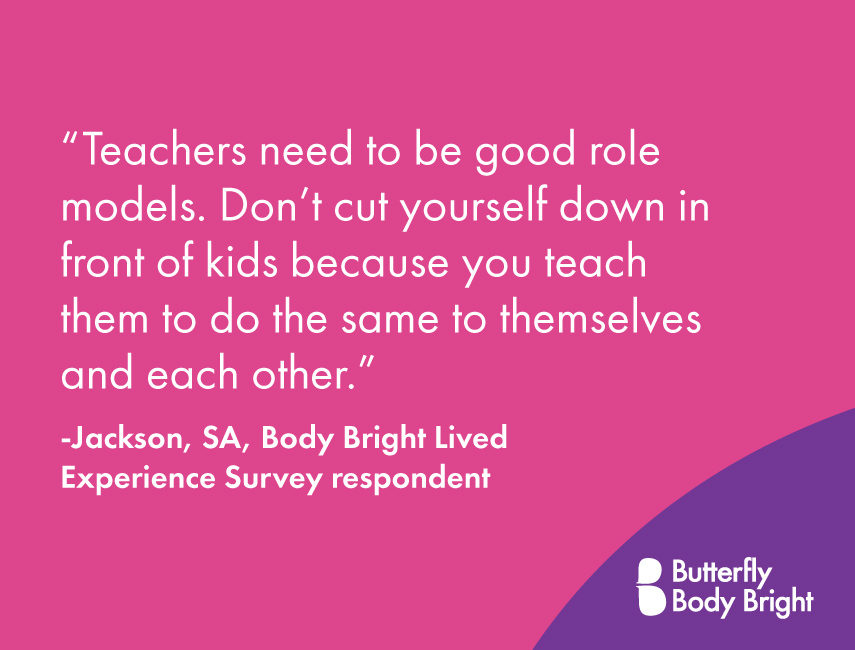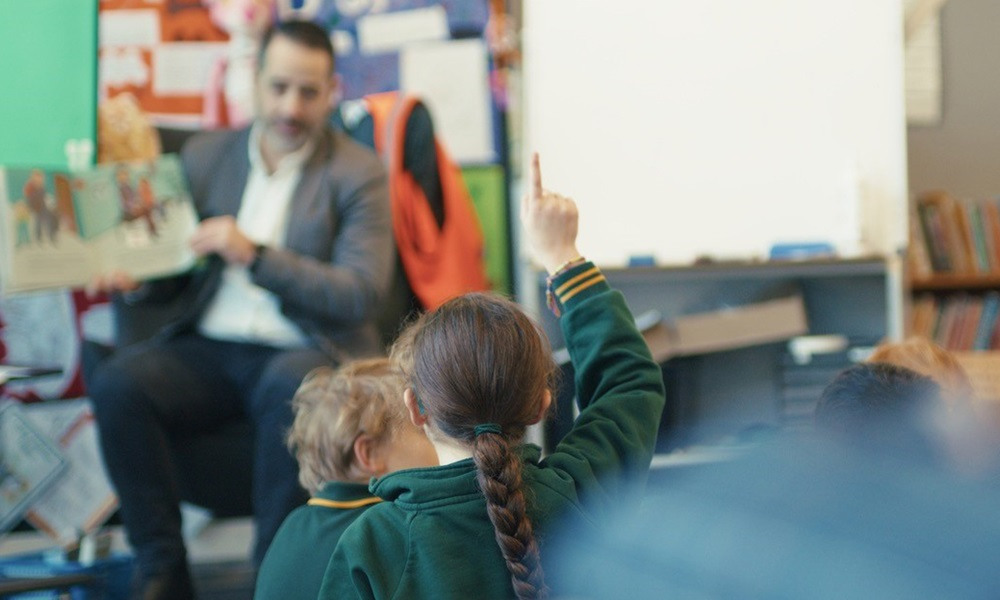Imagine this scenario… you overhear a student, or colleague, say, ‘I hate my body. I want to lose weight.’ How do you respond? Are you tempted to say, ‘Me too!, I get it’, or advise them to make better food choices and exercise?
You’re not alone, these kinds of thoughts are common, particularly in our world where we are surrounded by unhelpful messages that tie our value to how we look. But here’s the thing – this response reinforces societal ideals of thinness, perpetuates weight stigma, and could inadvertently contribute to unhealthy behaviours that may lead to an eating disorder.
In schools, we have an opportunity (and a responsibility) to respond differently. A more compassionate response, such as ‘It’s not always easy to like our bodies. What are some things you appreciate about what your body can do?’ can open a positive conversation about body appreciation.
The Butterfly Body Bright program provides a framework to help primary schools take significant steps toward achieving both staff and student self-compassion and body appreciation.

The hidden cost of body dissatisfaction in schools
Body dissatisfaction isn’t just a teenage or adult issue. It’s affecting Australian primary school children, with far-reaching consequences for their wellbeing and learning. Research shows that around 50% of pre-adolescent girls (aged 8–11) feel dissatisfied with their bodies, often wishing to be thinner (Paxton & Damiano, 2017). Boys aren’t immune either – around one-third of 6-year-old boys wish they had more muscles (McLean et al., 2018).
Childhood is a foundational period for the development of body image. In fact, 93% of adults in the Body Bright Lived Experience Survey reported that their body dissatisfaction, first experienced in primary school, worsened during adolescence. It's also well-established that body image impacts mental and physical wellbeing, including self-esteem, eating and physical activity behaviours, social relationships, participation in hobbies, risk of depression and anxiety, and the development of eating disorders. What may be less considered is how body dissatisfaction can significantly disrupt school attendance and academic engagement.
Butterfly’s BodyKind Youth Survey over 3 years has shown that for around half of young people (aged 12-18) their body image impacts their engagement in the classroom, focusing on schoolwork, or whether they even attend school. Research with 8- to10-year-old children has shown that low levels of body satisfaction were associated with declines in paying attention in class and trying hard to do well at school (Guimond & Laursen, 2022).
Young people want schools to take action
The BodyKind Youth Survey revealed that 80% of teens believe primary schools should do more to support positive body image, and 90% feel the same about high schools. Furthermore, 88% believe school staff should be trained in how to support body image.
Teachers need support too
Teachers and school staff play a pivotal role in shaping the body image environment of a school. Many educators, however, report feeling ill-equipped to address these issues and are seeking professional development and age-appropriate resources to better support their students (Damiano et al., 2018; Pursey et al., 2022).
The Butterfly Body Bright program is designed to empower school staff with the tools they need to foster a positive body image culture in schools. This includes training on how to be an effective role model, identify early warning signs, and build an inclusive, supportive environment for all students.
Educators are role models

The way teachers talk about bodies, food, and physical activity can have a profound influence on their students. Yet, teachers are not immune to the pressures around appearance and bodies in today’s society. Research indicates that many teachers experience body dissatisfaction, dieting, and disordered eating behaviours, which can unintentionally be passed down to students (Yager & O’Dea, 2009). This creates a complex dynamic where educators are expected to model positive behaviours while managing their own body image experiences.
But the Body Bright Staff Training is helping to overcome these challenges. After completing the training, 89.5% of staff reported an improved intention to model positive body image in front of their students.
The example that I set is critically important. I am very critical of my own body and have struggled with being overweight for my whole life. I don't want to pass this on to the kids I teach and feel that this training has given me the tools to do this. (Dave, SA, Body Bright Staff Training completer)
The power of staffroom culture
A key insight from the Body Bright Educator Reference Group was the importance of staff-to-staff interactions. Negative body talk refers to the negative things people can say about their body and/or appearance. Sometimes these self-critical comments are made to try to help others feel better about their body. However, extensive research has shown the very damaging impact this can have on the psychological wellbeing, body image, and eating disorder risk of those participating or even merely exposed to it (for example Warnick et al., 2022).
The Body Bright Staff Training includes strategies to avoid negative body talk, diet ‘challenges’, and unhelpful conversations in the staffroom. A colourful staffroom poster even acts as a reminder for positive body image language and actions. And it’s working – many educators are reporting a significant shift in how body image is discussed in their schools.
More awareness amongst staff of the language they are using in day-to-day conversations that reinforce societal body ideals. (Amy, VIC, Body Bright Lead)
A holistic approach: supporting staff and students
Butterfly Body Bright goes beyond just providing resources for students. It also focuses on building the self-compassion and body appreciation of staff. Research shows that these strategies benefit both adults and children, helping everyone appreciate what their bodies can do rather than just how they look.
Self-compassion involves treating yourself with kindness when you face struggles or negative thoughts about your body. It’s often described as talking to yourself the way you would to a good friend. Body appreciation shifts the focus to celebrating what your body can do, rather than just how it looks. It can be a useful tool to build gratitude and respect for the body.
After completing the optional module in the Body Bright Staff Training, which provides staff an opportunity to reflect on, and build skills to support, their own body appreciation and self-compassion, 90.8% of staff reported a positive impact on their body image, and 92.2% felt their self-compassion had increased after completing the course.
Tips for supporting self-compassion and body appreciation in your school
- Practice daily affirmations that focus on body functionality, inner qualities, and strengths.
- Model positive self-talk about your body and avoid negative appearance-based comments – encourage this in your students.
- Encourage gratitude activities in the classroom. Help students reflect on what their bodies allow them to do. Butterfly Body Bright provides lesson plans to do this from Foundation to Year 6.
- Use inclusive language that celebrates diversity in bodies, abilities, and appearances.
- Foster a safe environment by ensuring appearance-based teasing and bullying is not tolerated.
- Engage in mindful movement that focuses on enjoyment and fun, not appearance.
- Seek support for yourself or a student. Butterfly’s National Helpline is a great place to start.
Butterfly Body Bright – A whole-school solution
Butterfly Body Bright is a strength-based, evidence-informed body image program for primary schools. It nurtures positive body image and healthy relationships with eating and physical activity in children from Foundation to Year 6. The school-led program offers flexible implementation of HPE curriculum-aligned lesson plans, self-paced online staff training, school culture guidelines, family resources, and more.
By supporting both student and staff wellbeing, Butterfly Body Bright empowers schools to foster environments where everyone can thrive.
It’s helped us be more confident in our own bodies and be more understanding of others. It’s also helped us feel happy and grateful about our own bodies and the bodies of others. (Grade 5 student, VIC)
Find out more about Butterfly Body Bright and pricing at www.butterflybodybright.org.au or register your primary school today!
References
Damiano, S. R., Yager, Z., McLean, S. A., & Paxton, S. J. (2018). Achieving body confidence for young children: Development and pilot study of a universal teacher-led body image and weight stigma program for early primary school children. Eating Disorders, 26(6), 487-504.
Guimond, F. A., & Laursen, B. (2022). Low body image satisfaction predicts declining academic engagement in primary school children. School Mental Health, 14(4), 891-901.
McLean, S. A., Wertheim, E. H., & Paxton, S. J. (2018). Preferences for being muscular and thin in 6-year-old boys. Body image, 26, 98-102.
Paxton, S. J., & Damiano, S. R. (2017). The development of body image and weight bias in childhood. Advances in child development and behavior, 52, 269-298.
Pursey, K. M., Hart, M., Hure, A., Cheung, H. M., Ong, L., Burrows, T. L., & Yager, Z. (2022). The needs of school professionals for eating disorder prevention in australian schools: a mixed-methods survey. Children, 9(12), 1979.
Warnick, J. L., Darling, K. E., West, C. E., Jones, L., & Jelalian, E. (2022). Weight stigma and mental health in youth: A systematic review and meta-analysis. Journal of Pediatric Psychology, 47(3), 237-255.
Yager, Z., & O'Dea, J. (2009). Body image, dieting and disordered eating and activity practices among teacher trainees: implications for school-based health education and obesity prevention programs. Health education research, 24(3), 472-482.

